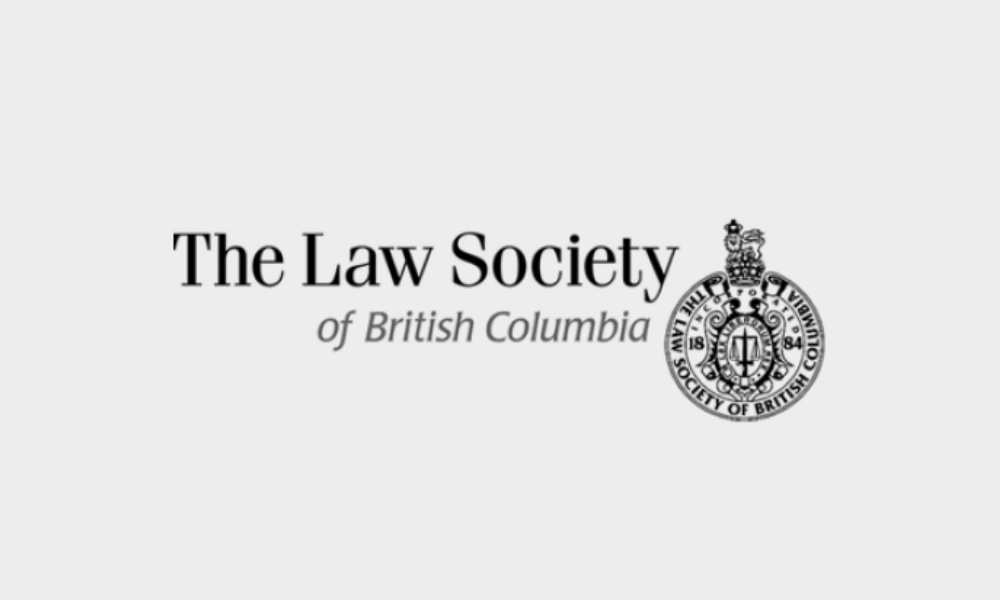
But bencher resolutions controlling which members' motions can be brought to the floor were defeated

Members at the 2021 annual general meeting of the Law Society of British Columbia earlier this week voted down a motion to open debate on a practice directive of the B.C. courts on how gender pronouns (he, she, they) should be used during court proceedings.
Those who cast votes also passed a resolution to implement changes to the members’ portal and lawyer directory on the society’s website to reflect the use of “he,” “she,” or “they.”
In an emailed statement, law society president Dean Lawton said "the results of the annual general meeting affirm the direction that the law society has been taking to ensure inclusion and respect of all members of the public and the legal profession." He added that the board of benchers and the law society staff look more closely at [the resolution dealing with the members' portal and lawyer directory] as we consider the next steps to take in the implementation of our diversity action plan."
Member resolutions from the AGM are non-binding, and the society says it is considering the resolution passed at this week's meeting in the context of the work it is already developing.
The topic of gender pronouns in the courts has been contentious in B.C. in recent months. In December, the Supreme Court of B.C. issued a practice directive on the use of gender-inclusive language in court. An almost identical provincial court notice was also released that asked participants in proceedings to indicate which pronouns (they, he, or she) should be used.
Provincial Court Chief Judge Melissa Gillespie wrote last December that “to help judicial officers, lawyers, and litigants,” the court’s notice clarifies “how parties and lawyers can advise judicial officers and other parties and lawyers of their pronouns and form of address.”
The directive asks those participating in proceedings to state their name, title, and the pronouns to be used in the proceeding, and for lawyers to provide this information for their clients. An example of how to address the court would be: “My name is Ms. Jane Lee, spelled L-E-E. I use she/her pronouns. I am the lawyer for Mx. Joe Carter who uses they/them pronouns”. (“Mx.” is pronounced like the word “mix” and is a gender-neutral salutation.)
If a party or lawyer does not provide this information in their introduction, they will be prompted by a court clerk to do so. “For instance, the court clerk may say ‘For the record, I would ask counsel for the applicant to introduce themselves and their client, including their pronouns and title such as Ms., Mr., Mx., or Counsel’.”
Since the directives were issued, strong opinions have been voiced by lawyers on either side of the issue — with those in favour of the directives saying criticism of them is akin to hate speech, and those who want more debate on the topic saying the other side is trying to censor their views.
For the first resolution, calling for a debate on the use of gender pronouns, 42.08 per cent of the 3,363 votes cast were in favour of the motion (1,415), while 57.92 per cent (1,948) were against. This included advance voting and votes cast during the meeting. There were 344 abstentions.
On the second resolution, to implement gender pronoun changes to the member portal and lawyer directory, of the 3,214 votes cast, 2,220, or 69.07 per cent, were in favour of the motion, while 994 votes, or 30.93 per cent, were opposed. There were 479 members who abstained.
However, two other benchers’ resolutions that appear to be related to the discussion on the use of gender pronouns were defeated by not getting two-thirds support.
One resolution would have authorized benchers to amend the LSBC’s rules respecting general meetings by ensuring that a member’s resolution must be signed by at least 50 members of the society to be considered at an annual general meeting.
A commentary accompanying this resolution says that law society rules require that only two members in good standing are needed to put forward a member resolution for consideration. It says, “the Bencher resolution to require 50 members to support including a member resolution on the annual general meeting agenda is intended to ensure that the resolution has the support of a meaningful constituency and not just two members while also ensuring the process is still reasonably accessible to members.”
The other benchers’ resolution, had it passed, would have authorized benchers to amend the rules on general meetings to allow the society’s president (who chairs the AGM) to determine in advance if a member resolution submitted for consideration is in order. This is essentially a veto power of the president to determine if a proposed motion is “reasonably related to the mandate or responsibilities of the Law Society or the benchers, or to the regulation of the legal profession.”
Critics of these proposed motions suggested that they were a means to silence politically incorrect views, while those in favour felt that they would provide a baseline for not accepting motions that reflected fringe opinions.
Both resolutions received a majority of votes in favour of the resolution (59 per cent for the 50-member support resolution and 46 for the veto power motion). However, the Legal Profession Act in B.C. requires two-thirds approval of members voting at a general meeting or in a referendum to permit benchers to make rule changes with respect to general meetings.